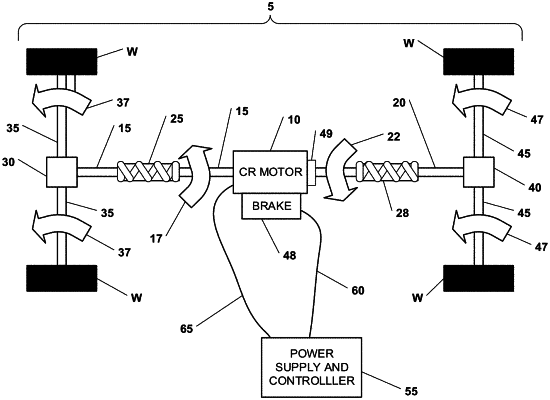| CPC B60W 30/188 (2013.01) [B60K 1/00 (2013.01); B60K 17/02 (2013.01); B60K 17/16 (2013.01); B60K 17/356 (2013.01); B60L 15/2009 (2013.01); B60W 10/08 (2013.01); B60W 10/14 (2013.01); B60W 30/182 (2013.01); B60K 2001/001 (2013.01); B60L 2220/50 (2013.01); B60Y 2200/91 (2013.01); B60Y 2200/92 (2013.01)] | 14 Claims |

|
1. A vehicle that utilizes a counter-rotating (CR) electric motor that automatically switches between a high efficiency CR motor mode of operation at lower vehicle speeds to a less efficiency traditional motor mode of operation at higher vehicle speeds to generate at least a portion of its propulsive force, comprising:
(a) the vehicle having at least one front wheel and at least one rear wheel;
(b) a CR motor mounted to the vehicle, wherein said CR motor comprises:
(i) a first rotational member rotating in a first rotational direction about a central axis;
(ii) a second rotational member rotating in a second rotational direction about said central axis;
(iii) a first drive shaft attached to and extending from said first rotational member and rotating in said first rotational direction;
(iv) a second drive shaft attached to and extending from said second rotational member and rotating in said second rotational direction;
(v) at least one set of electromagnets associated with one of said first and second rotational members; and
(vi) electrical input means for powering and controlling said set of electromagnets;
(c) a first means for coupling said first drive shaft to said front wheel;
(d) a second means for coupling said second drive shaft to said rear wheel;
(e) means for matching said first drive shaft rotational direction with said second drive shaft rotational direction to produce a common rotational direction for said front and rear wheels;
(f) a first means for reversibly stopping the rotation of one of said first and second rotational members while permitting said first and second drive shafts to rotate;
(g) a power source linked to said CR motor for providing electricity; and
(h) a programmable controller in communication with said CR motor and said first reversible stopping means that controls both the speed of the vehicle and said first stopping means to switch between a first operational mode in which both rotational members are rotating for slower vehicle speeds and a second operational mode in which one of said rotational members is stopped by said stopping means, thereby creating a traditional electric motor for higher vehicle speeds, thereby increasing the overall electrical efficiency for operating the vehicle.
|